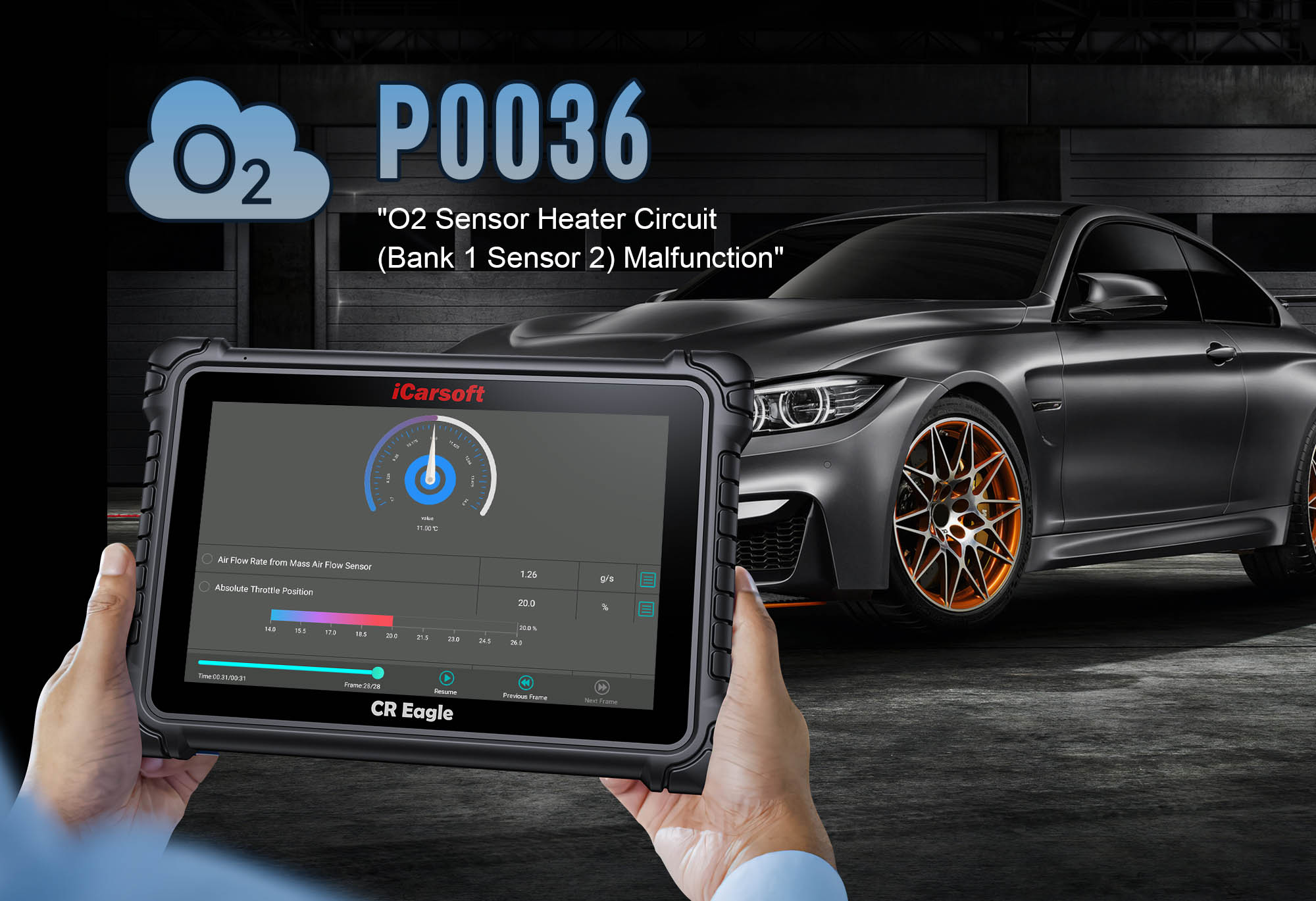Diagnose and Clear P0036: Fix Oxygen Sensor Heater Circuit (Bank 1, Sensor 2) with iCarsoft CR Eagle
When your vehicle’s check engine light turns on and a diagnostic scan returns the P0036 code, it’s signaling an "Oxygen Sensor Heater Circuit Malfunction (Bank 1, Sensor 2)". This code targets the secondary oxygen sensor (post-catalytic converter, known as Sensor 2) on Bank 1 of the engine, specifically its heating circuit. The oxygen sensor’s heater is critical for quickly warming the sensor to operating temperature (around 600–800°F), ensuring accurate exhaust gas readings to optimize fuel mixture and reduce emissions. A faulty heater circuit can delay sensor activation, leading to poor fuel efficiency, increased emissions, and even catalytic converter damage. With the iCarsoft CR Eagle, you can pinpoint the root cause of P0036, make targeted repairs, and clear the code reliably. Let’s walk through how to resolve this issue.
Understanding P0036: The Role of the Oxygen Sensor Heater
Oxygen sensors (O2 sensors) monitor the amount of unburned oxygen in the exhaust, sending data to the engine control module (ECM) to adjust fuel injection. The secondary O2 sensor (Bank 1, Sensor 2) checks the efficiency of the catalytic converter by comparing exhaust gases before and after the converter. To work properly, O2 sensors need rapid heating—this is where the heater circuit comes in: a small heating element inside the sensor, powered by the vehicle’s electrical system, brings the sensor to operating temperature in 1–2 minutes (vs. 5–10 minutes without heat). When the heater circuit (wires, connector, or heating element) malfunctions, the sensor takes too long to activate (or fails to activate), and the ECM triggers P0036.
Symptoms of P0036
-
Illuminated Check Engine Light: The primary indicator of a heater circuit issue.
-
Poor Fuel Economy: Delayed sensor activation causes the ECM to use a "rich" default fuel mixture, wasting fuel.
-
Increased Emissions: Inaccurate O2 sensor data leads to unoptimized combustion, raising hydrocarbon and carbon monoxide emissions (risk of failing smog tests).
-
Catalytic Converter Risk: A rich fuel mixture can overheat the catalytic converter, reducing its lifespan or causing permanent damage.
-
Rough Idle (Rare): In severe cases, prolonged sensor inactivity may disrupt fuel balance, leading to mild rough idling.
Common Causes of P0036
|
Cause
|
Description
|
|
Faulty O2 Sensor Heater Element
|
Burned-out heating element inside the sensor, preventing proper warming (most common cause).
|
|
Damaged Heater Circuit Wiring
|
Frayed, cut, or corroded wires breaking the electrical path between the sensor and power supply/ECM.
|
|
Loose or Corroded Connector
|
Dirt, moisture, or vibration damaging the O2 sensor’s connector, blocking power or signal flow.
|
|
Blown Fuse or Relay
|
A fuse (labeled "O2 Heater") or relay powering the heater circuit blows, cutting power to the heater.
|
|
ECM Malfunction
|
Rare, but ECM fails to send correct voltage to the heater circuit (less common than sensor/wiring issues).
|
Why iCarsoft CR Eagle Excels at Diagnosing P0036
The iCarsoft CR Eagle is designed to simplify O2 sensor heater circuit diagnostics, going far beyond basic code reading. Here’s its key value for P0036:
Heater Circuit Testing Precision
Voltage and Current Checks
Measures 12V voltage at heater pins and current flow (0.5–1.5A). No voltage indicates power issues; no current points to a faulty heater element.
Heater Activation Tests
Manually activates the O2 sensor heater via bi-directional control to verify operation—confirms if the issue is the sensor or circuit.
Real-Time Sensor Monitoring
Heater Status Tracking
Streams live data showing if the heater is "Active" or "Inactive," confirming if the ECM is sending power.
Sensor Temperature Readings
Displays internal sensor temperature—failure to reach 600°F within 2 minutes confirms heater malfunction.
Vehicle-Specific Guidance
Sensor Location Diagrams
Detailed maps showing Bank 1, Sensor 2 position (post-catalytic converter) for your vehicle (Toyota, Chevrolet, etc.).
Manufacturer Specs
Stores default heater voltage (12V) and current (0.5–1.5A) ranges for quick out-of-spec identification.
Step-by-Step: Diagnosing and Clearing P0036 with iCarsoft CR Eagle
-
Confirm the Code and Check for Related Issues
Connect the CR Eagle to the OBD-II port, power on, and select your vehicle (use AutoVIN). Navigate to "OBD-II" > "Read Codes" to confirm P0036. Note related codes (e.g., P0030 for Bank 1, Sensor 1; P0056 for Bank 2, Sensor 2) to rule out multiple sensor problems.
-
Test the Heater Circuit Power Supply
Go to "Special Functions" > "Oxygen Sensor" > "Heater Circuit Test." The CR Eagle checks 12V voltage at the sensor connector. Use "Fuse Location" to find and test the O2 heater fuse (replace if blown). Test the relay if voltage remains missing after fuse replacement.
-
Activate the O2 Sensor Heater
Select "Bi-Directional Control" > "O2 Sensor Heater Activation." Monitor "Heater Current" in live data—healthy range is 0.5–1.5A. No current means a faulty heater element (replace the sensor). Normal current with no warming indicates wiring damage (use "Continuity Test").
-
Inspect the O2 Sensor and Connector
Use "Component Location" to find Bank 1, Sensor 2 (ensure engine is cool). Disconnect the connector—check for corroded pins (clean/replace), loose wires (repair with heat-shrink), and sensor damage (e.g., oil contamination).
-
Verify Sensor Temperature (If Supported)
Access "Live Data" > "Oxygen Sensors" > "Sensor 2 Temperature" (Bank 1). Start the engine—healthy sensors reach 600°F within 2 minutes. Sub-500°F readings confirm a faulty heater (replace sensor).
-
Repair and Clear the Code
Replace the faulty O2 sensor (use OEM/high-quality aftermarket), repair wiring, or clean the connector. Select "Clear Codes" to erase P0036.
-
Confirm Repairs
Run the engine for 10 minutes and check "Heater Status" (should show "Active"). Test drive (highway/city) and re-scan—no code recurrence confirms success.
Tips to Prevent P0036 from Recurring
-
Inspect O2 Sensor Connectors Quarterly: Check during oil changes; apply dielectric grease to repel moisture and prevent corrosion.
-
Replace O2 Sensors on Schedule: Manufacturers recommend replacement every 60,000–100,000 miles (heater elements wear over time).
-
Protect Wiring Harnesses: Secure exhaust-area wiring away from hot components with wire loom to prevent heat damage.
-
Use the CR Eagle for Monthly Checks: Run "Oxygen Sensor Health Scan" to monitor heater status and temperature, catching issues early.
Final Take: Master P0036 with CR Eagle
The P0036 code highlights a critical issue with your secondary oxygen sensor’s heater circuit—ignoring it risks poor fuel economy, emissions failures, and catalytic converter damage. With the iCarsoft CR Eagle’s advanced tools—heater activation tests, voltage monitoring, and live temperature tracking—you can pinpoint whether the problem is a faulty sensor, blown fuse, or damaged wiring.
Whether you’re a DIY enthusiast or technician, the CR Eagle eliminates guesswork, ensuring you fix the root cause efficiently. Don’t let a faulty O2 sensor heater drain your gas tank—trust the CR Eagle to restore optimal exhaust system performance.
FAQs About P0036 Code
Q: Can I drive with P0036?
A: Yes, but prolonged driving reduces fuel efficiency and risks catalytic converter damage. Address within a few hundred miles.
Q: How much does it cost to fix P0036?
A: $80–$200 for an O2 sensor replacement; $30–$100 for wiring/connector repairs. Fuses/relays cost $10–$30.
Q: What’s the difference between P0036 and P0031?
A: P0036 is Bank 1, Sensor 2 (secondary, post-cat); P0031 is Bank 1, Sensor 1 (primary, pre-cat) heater circuit malfunction.
Q: Will a bad catalytic converter cause P0036?
A: No, but a failing converter can overheat the O2 sensor over time. P0036 is strictly an electrical/heater issue.





